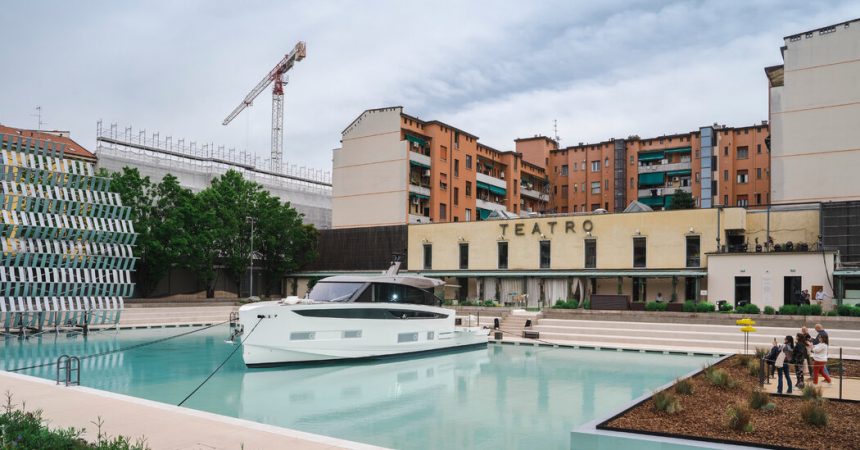This article is part of our Design special section about water as a source of creativity.
In the middle of Milan Design Week last month, in the middle of the Bagni Misteriosi — a historic bathing complex in the Porta Romana neighborhood — the Italian luxury shipbuilder Azimut Yachts hosted an unusual exhibition. It was a celebration of the company’s latest offering: the Seadeck 6, which made its debut last year and features interiors by the design team of Matteo Thun and Antonio Rodriguez.
Having been lowered into the facility by crane, the nearly 60-foot vessel was set afloat in an outdoor swimming pool. There it bobbed, traversed by hordes of well-coiffed guests while a concealed apparatus shrouded it in bursts of atmospheric steam. Surreal, elegant, not a little absurd, it was a scene straight out of Fellini, with overtones of Werner Herzog’s boat-hoisting epic “Fitzcarraldo.”
But the thing that made it most unusual? “Azimut wanted to make this the most sustainable boat on the market,” Mr. Rodriguez said. “We tried to do that.”
The ultimate playthings for the ultrawealthy, high-end pleasure craft would not seem optimal candidates for greening. Yet a growing number of manufacturers and designers are trying to change that, producing yachts both large and (comparatively) small assembled from fewer and less carbon-intensive materials, requiring a fraction of the power to run and drawing more of their energy from renewable sources.
In a peculiar twist for an industry uniquely exposed to supply-chain shocks and the vicissitudes of geopolitics (the loss of the once-lucrative Russian market continues to smart), global brand leaders appear to be making the move toward energy efficiency of their own accord, rather than in response to any explicit demand from their clientele.
“We will have to see if the world is ready,” said Giovanna Vitelli, Azimut’s chairwoman, as she stood aboard the Seadeck 6 during its not-quite maiden, not-quite voyage.
It is an approach that entails some risk. In January, Silent Yachts — an Austrian solar-electric catamaran company with facilities in Fano, Italy — was reported to be approaching bankruptcy amid problems with both its corporate parent and a key subcontractor. A former client stepped in to rescue the brand from insolvency, yet challenges remain. In a recent interview with the trade publication Superyacht News, the company’s new chief operating officer, Fabrizio Iarrera, spoke of the “costs associated with creating an entirely new market.”
Still, the push toward more sustainable yachting appears to be barreling forward, part of a broader shift in the role of design in the industry. Seven years ago, Bonetti/Kozerski Architecture in New York — known for its plush hotel interiors for the hospitality magnate Ian Schrager — was invited by Azimut’s sister company Benetti to develop a new yacht concept, the Oasis. It was one of the rare instances in which Benetti, founded in 1873, had sought out collaborators with no previous maritime experience, and all parties took it as an opportunity to import a set of values they viewed as lacking in the boating world.
According to Enrico Bonetti, the architecture firm’s co-founder, boat design previously favored grand spaces that no one actually liked. “There’s always this big table nobody’s using, then you step into another place with shiny things,” he said. “We didn’t follow that.” With its open, airy living space, wood paneling and notable lack of gold leaf, the Oasis represented a more humane vision for the yacht of the future, one constrained by at least the appearance of refinement and reserve, though it was ritzy nonetheless.
That low-key tendency is very much in line with the decarbonization campaign now underway at Azimut and other builders. In recent years, design studios like Zaha Hadid Architects and Pininfarina have turned out yacht proposals that pair sleek visuals with reduced reliance on fossil fuels; later this year, Yves Béhar, the Swiss-born product and furniture maestro, will unveil his own take on the trend — a catamaran designed for an as-yet unnamed manufacturer. “It’s essentially an E.V.,” said Mr. Béhar, who was also in Milan for the design fair.
Underlying the designer eco-yacht phenomenon is the intuitive sense, as Antonio Rodriguez put it, that “silent luxury” is fast displacing opulence. Where previous generations of yachters sought to flaunt their wealth, today’s owners may be less keen to draw attention to their own affluence. In reducing their carbon footprint, boatmakers are hoping to lure customers eager to reduce their profile, while still allowing them to ply the seven seas in style.
The Seadeck 6 certainly does that. With a crisp, white exterior — the work of the veteran yacht designer Alberto Mancini — the ship sleeps up to eight in three below-deck cabins. Topside, guests can sprawl in fore and aft lounges, or take lunch prepared in a semi-concealed galley, served on an elegant foldout table. The interior palette is muted, the contours soft, and everywhere, Ms. Vitelli said, the intention was to let people “feel close to water” rather than immuring them in an oceangoing penthouse.
Relatively speaking, the Seadeck’s ecological credentials are also impressive. Nearly every feature has been retooled for minimal environmental impact: replacing the customary teak deck with sustainably sourced cork; covering the walls and upholstering the seating with organic and recycled materials; even sealing the hull with something the company refers to as an ‘eco-gel finish.’” Most important, the craft incorporates a still-novel (for marine propulsion) hybrid engine, capable of a top speed of 33 knots with the ability to navigate about 200 miles offshore — enough for a quick spin from Fort Lauderdale to the Bahamas.
Add it together, and the company claims the Seadeck 6 and its larger cousin, the 71-foot Seadeck 7, achieve an operational carbon output 60 percent that of comparable vessels.
It’s a start, but only that. A comparative analysis with a similarly sized Azimut product — coupled with statistics from the Environmental Protection Agency — suggests that the cruise from Fort Lauderdale to Nassau would contribute roughly 4,400 pounds of carbon dioxide on the Seadeck 6, well over what the average American produces in a month.
And then there are the more immediate costs: around $2.8 million for the Seadeck 6 and $4.25 million for the Seadeck 7. Ms. Vitelli said the company hopes that enough buyers will come aboard to make price reductions possible in future.
A lot is riding on these hopes. Elsewhere in Milan, at the giant exhibition hall of the Salone del Mobile furniture fair, a talk session with a group of yacht experts underscored the stakes: During the panel, Stefano de Vivo, the chief commercial officer of the luxury yacht brand Ferretti Group, presented a slide showing Italy’s dominance in the custom-yacht sector, with domestic manufacturers taking a large share of the $9 billion global marketplace.
Mr. de Vivo declared sustainability essential to shipbuilding’s ongoing success and spoke of a general convergence with the design field at large. “As a shipyard, we’ve had to become less ‘marine,’” he said.
Back at the Bagni Misteriosi, mariners did seem in somewhat short supply, as various design lovers and Salone personalities (including the celebrated architect Michele de Lucchi, who helped create an on-site installation for Azimut) swanned around the bathhouse garden and its waterborne centerpiece. As an image of an ecologically sensitive future, the spectacle seemed off the mark — but then the Seadeck’s creators are careful not to make any overly sweeping claims as to whether their yacht, or any yacht for that matter, can truly be deemed an ecological asset.
“We don’t really like the word ‘sustainable,’” Mr. Rodriguez said. “We prefer to say it’s ‘conscious.’”






